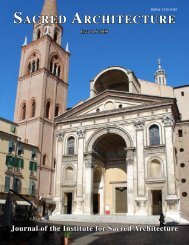Download Issue PDF - The Institute for Sacred Architecture
Download Issue PDF - The Institute for Sacred Architecture
Download Issue PDF - The Institute for Sacred Architecture
- No tags were found...
You also want an ePaper? Increase the reach of your titles
YUMPU automatically turns print PDFs into web optimized ePapers that Google loves.
B O O K SPONTIFICAL PATRONAGERejoice! 700 Years of Art <strong>for</strong> the PapalJubilee, edited by Maurizio Calvesi withLorenzo Canova, New York: Rizzoli, 1999.239 pages. $75.00.Reviewed by Michael Morris, O.P.REJOICE! is a very dumb title <strong>for</strong> a verysmart book. <strong>The</strong> title smacks too muchof those mindless felt and burlap bannersfrom the trendy 1960’s which look like anembarrassment to us now. But this bookhas the finer arts in focus. <strong>The</strong> Rizzoli publication,which is a compilation of twentyfouressays by a variety of Italian scholars,looks at 700 years of papal artistic patronage<strong>for</strong> the Jubilee Yearsthat brought pilgrimsfrom around the worldto Rome. <strong>The</strong> superblyillustrated coffee-tablebook covers both artand architecture.Pope Boniface VIIIpromulgated the firstJubilee in the year 1300.His annus iubilaeus wasrooted in the traditionof the Hebrew feast ofthe Jubilee. <strong>The</strong> feast occurredevery fifty yearsand was dedicated tothe sanctification of society.<strong>The</strong>re was neitherharvesting nor sowing;the land was left fallow.Freedom was restoredto the slaves, propertyreturned to its originalowners. Debts werecancelled. For the Christiansof the MiddleAges, the call to Rome was an opportunityto cancel temporal punishment due to sin.By papal edict, the faithful could gain indulgencesby going on pilgrimage and visitingthe sacred basilicas in the Eternal City.How often these Jubilees would be heldwas a matter not settled <strong>for</strong> several centuries.One-hundred-year intervals and thirtythree-year intervals (supposedly the lengthof Christ’s time on earth) were tried until itwas finally decided that the Holy Yearwould occur every twenty-fifth year, save<strong>for</strong> special occasions when an “extraordinary”Jubilee might be called <strong>for</strong> specialreasons. Throughout the centuries, thepopes prepared <strong>for</strong> such events by sponsoringelaborate building programs andcommissioning beautiful works of art. APiazza del Popolo, Rome, Italysweeping view of these achievements is theobject of these essays, and they have beenmasterfully edited by Maurizio Calvesi, aprofessor of art history at the University ofRome.Students of architecture will appreciateespecially the chapter on the Jubilee calledby Pope Sixtus IV in the year 1475. Becausethe Holy Land was controlled by the Mohammedans,Rome took deliberate meansto become a substitute destination <strong>for</strong> pilgrimswho longed to go to Jerusalem. <strong>The</strong>papacy appropriated <strong>for</strong> itself and at thesame time confronted the potent symbolismof the Jewish High Priesthood and theglorious Temple of Solomon. <strong>The</strong> scholarsof this book prove that it is by no mere coincidencethat the dimensions of the SistineChapel are identical to the dimensions ofSolomon’s Temple. An inscription found inthe Chapel reads: “You, Sixtus IV, inferiorto Solomon in wealth, but superior to himin religion and devotion, consecrated thisimmense temple.” In 1500 the Jubilee ofAlexander VI embellished the Church ofSanta Croce in Gerusalemme, reputedlybuilt on the site of the Empress Helena’spalace, which contained the many relics ofChrist’s Passion retrieved from her extraordinaryarchaeological expedition to theHoly Land in the fourth century. He alsohad a group of medieval and ancient buildingshurriedly demolished (including thefabled Meta Romuli, a sepulchral pyramidnamed after the founder of Rome) to createa traffic-friendly avenue that connectedCastel Sant’Angelo with St. Peter’s Square.Running out of time, the pontiff was <strong>for</strong>cedto mobilize pilgrims to help clear therubble themselves! <strong>The</strong> conflict betweenthe remains of antiquity and papal buildingprograms continues to haunt the JubileeYear, but today more conservationistminds prevail.<strong>The</strong> art and illustrations of REJOICE!tend to favor painting and prints over architecture,but throughout the book thevarious art <strong>for</strong>ms tend to complement eachother rather than compete. How else mightthe authors have portrayed the developmentsmade at the Basilica of Santa MariaMaggiore, the Piazza of St. Peter’s, and thePantheon without utilizing the graphicwork of Piranesi?Beautiful photographsrecord thecurrent state ofother Jubileebuildings: the CasinodelBelrespiro, thetwin churches ofthe Piazza delPopolo, the sacristyof St. Peter’s,the Museo PioClementino, andthe churches ofDivina Sapienzaand MariaMediatrice inRome. In comparison,a model<strong>for</strong> RichardMeier’s Church<strong>for</strong> the Jubilee of2000 looks jarringlyout ofplace. This modernistexclamation in the realm of classicismseems less a prediction <strong>for</strong> the futurethan a faint echo of masterpieces from thecentury past, most notably the Sydney OperaHouse. Yet it is the variety of artisticcommissions recorded in REJOICE! tyingparticular pontiffs with particular monuments,that rein<strong>for</strong>ces in the reader’s mindthe important role of patronage in the advancementof the arts, a noble activity thatnot only dazzles the eye, but feeds the soul.Photo: Calvesi, Rejoice! 700 Years of Art <strong>for</strong> the PApal Jubilee, 1999Rev. Michael Morris O.P. teaches classes inart and film at the Graduate <strong>The</strong>ological Unionin Berkeley and directs the Santa Fe <strong>Institute</strong><strong>for</strong> Catholic Faith and Culture.<strong>Sacred</strong><strong>Architecture</strong> Fall 2000 31










